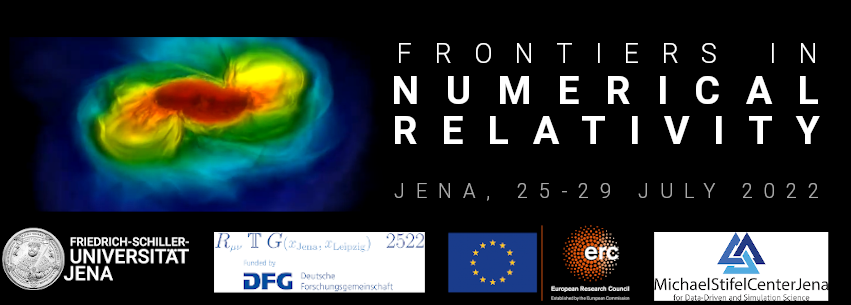Speaker
Description
GW190425 was the second gravitational wave (GW) signal compatible with a binary neutron star (BNS) merger detected by the Advanced LIGO and Advanced Virgo detectors. Despite intense follow-up campaigns, no electromagnetic counterpart was identified. Whether the associated kilonova was too dim or the localisation area too broad is still an open question. We simulate 28 BNS mergers with the chirp mass of GW190425 and spanning a mass ratio 1 ≤ q ≤ 1.67, using numerical-relativity simulations with finite temperature, composition dependent nuclear equation of state (EOS) and neutrino radiation. The energy emitted in GWs is less than 0.083 Mo 𝑐^2, where Mo is the solar mass, with a peak luminosity of 1.1 − 2.4 × 10 58 erg s^−1 /(1 + q)^2 . Dynamical ejecta and disc mass are relatively small, the former ranging between 5 × 10^−6 and 10^−3 solar masses and the latter between 10^−5 and 0.1 solar masses . Asymmetric mergers, especially in the case of stiff EOSs, are able to unbind more matter and to form heavier discs compared to equal mass binaries. The angular momentum of the disc is 8 − 10 Mo the disc mass over three orders of magnitude in the disk mass. While the associated nucleosynthesis shows no peculiarity, the simulated kilonovae are relatively dim compared with the GW170817 event. In particular, for distances compatible with GW190425, we find AB magnitudes always dimmer than 20 mag for the B, r and K bands, with brighter kilonovae associated to more asymmetric binaries and stiffer EOSs. We suggest that, even assuming a good coverage of GW190425’s sky location, the kilonova signal could hardly have been detected by present wide-field surveys and no firm constraints on the binary parameters or neutron star (NS) EOS can be argued from the lack of the detection.

